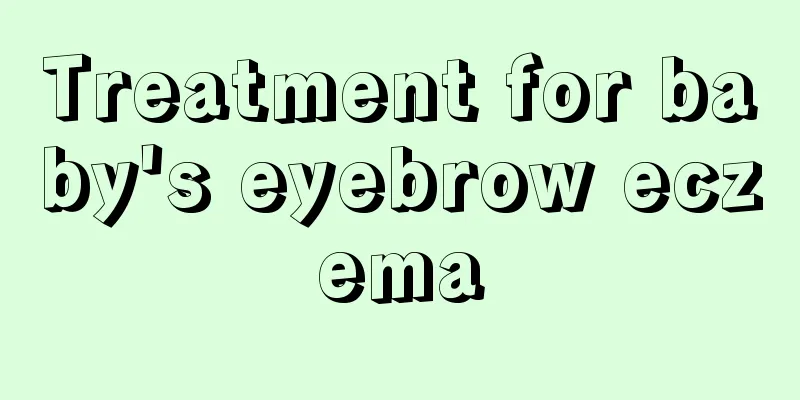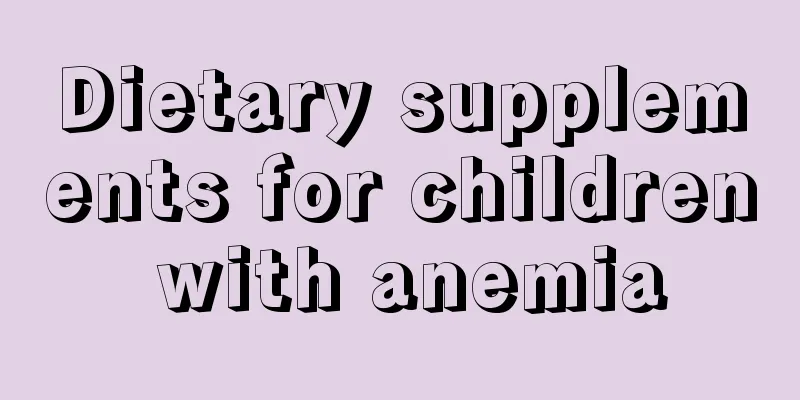Treatment for baby's eyebrow eczema

|
Problems like baby eyebrow eczema are prone to occur in a humid environment. We are prone to this disease if we stay in a humid environment for a long time. With the improvement of modern living standards, a series of diseases have also emerged. Examples of eczema are common. We may have all heard of eczema. It can be said that this is a skin disease. When it occurs, it will greatly damage the surface of our skin. It is not a disease, but it has caused great trouble to many people. Many people have run to many hospitals to find effective treatments. So what are some good ways to treat baby eyebrow eczema? Below we will introduce the specific treatment methods for baby's eyebrow eczema. Treatment: 1. General treatment Because the causes of urticaria vary, the treatment effects are also different. The specific treatment measures are as follows: (1) Eliminate the cause. Every patient should strive to find the cause of the attack and avoid it. If the cause is infection, the infected lesions should be treated actively. If the allergy is caused by drugs, the allergy medication should be stopped; if the allergy is caused by food, find out the allergic food and do not eat this food again. (2) Avoid inducing factors. For example, for cold urticaria, you should keep warm; for acetylcholine urticaria, you should reduce exercise, sweating and mood swings; for contact urticaria, you should reduce the chance of contact. 2. Medication (1) Antihistamine drugs ①H receptor antagonists have strong anti-histamine and anti-other inflammatory mediator effects and are effective in treating various types of urticaria. Commonly used H1 receptor antagonists include diphenhydramine, cyproheptadine, chlorpheniramine, acrivastine, cetirizine, mizolastine, loratadine, ebastine, azelastine, desloratadine, etc.; when single treatment is ineffective, two different types of H1 receptor antagonists can be used in combination or in combination with H2 receptor antagonists. Commonly used H2 receptor antagonists include cimetidine, ranitidine, famotidine, etc. It is effective for acute, chronic urticaria and cold urticaria. Dosage varies from person to person. ② Doxepin is a tricyclic antidepressant that is particularly effective for chronic urticaria and has fewer adverse reactions. Doxepin is a better choice of drug for patients with urticaria who are not responsive to traditional antihistamines. (2) Drugs that inhibit mast cell degranulation and reduce histamine release ① Meta-hydroxyisobutyrine sulfate is a β2 adrenergic receptor stimulator that can increase the concentration of cAMP in the body, thereby inhibiting mast cell degranulation. ② Ketotifen inhibits mast cell degranulation and prevents the release of inflammatory mediators (such as histamine, slow-reacting substances, etc.) by increasing the concentration of cAMP in the body. Its inhibitory effect is stronger and faster than that of sodium cromoglycate, and it can be taken orally. ③Sodium cromoglycate can block the binding of antigen and antibody and inhibit the release of inflammatory mediators. If used in combination with glucocorticoids, the dosage of the latter can be reduced and the therapeutic effect can be enhanced. ④ Tranilast reduces the release of histamine by stabilizing the mast cell membrane. (3) Glucocorticoids are second-line drugs for the treatment of urticaria. They are generally used when severe acute urticaria, urticarial vasculitis, and pressure urticaria are ineffective against antihistamines, or when chronic urticaria is severely stimulated. They are administered intravenously or orally, and long-term use should be avoided. Commonly used drugs are as follows: ① prednisone; ② triamcinolone; ③ dexamethasone; ④ diprosone. In emergency situations, hydrocortisone, dexamethasone, or methylprednisolone is given intravenously. (4) Immunosuppressants: When patients with chronic urticaria have an autoimmune basis and the disease recurs, and the above treatments cannot achieve satisfactory results, immunosuppressants can be used. Cyclosporine has a good therapeutic effect. Azathioprine, cyclophosphamide, methotrexate and immunoglobulin can all be tried. Tripterygium wilfordii also has a certain therapeutic effect. Due to the high incidence of side effects of immunosuppressants, they are generally not recommended for the treatment of urticaria. In addition, drugs that reduce vascular permeability, such as vitamin C, vitamin P, calcium supplements, etc., are often used in combination with antihistamines. If it is caused by infectious factors, appropriate antibiotics can be used for treatment. The above content introduces us to the relevant methods for baby's eyebrow eczema. I believe that the above content can be helpful to everyone. The above methods are proven and very effective methods. If we have friends with eczema around us, we must ask them to read it carefully. Thank you. There is no content. You might as well try the methods introduced above! |
<<: Treatment of infant cough with phlegm and runny nose
>>: Physical treatment methods for reducing fever in children
Recommend
Baby's motor development is delayed, these situations need attention
Parents are not only very concerned about their b...
How to relieve itching of urticaria in children?
Children's urticaria is a very common childho...
What should I do if my child only grows fat but not taller?
Children are the people we pay the most attention...
What to do if a child has red spots on his body
The physical health of children is what parents c...
Two-month-old baby milk intake standard
For babies, daily diet cannot be ignored. Because...
What can my baby eat to get better quickly when his runny nose comes out?
Children have relatively weak resistance and are ...
What are the best ways for children to lose weight?
Children nowadays are living more and more comfor...
17 steps to change newborn diapers
In the past, when there were no diapers, everyone...
Teething order for children
When the baby reaches a certain age, you need to ...
Reasons why babies wake up at night
Having a lovely baby at home will bring laughter ...
How to solve the problem of 3-year-old baby grinding teeth at night
We all know in our daily lives that as parents, i...
What to do if your child has dry stools
We all know that every child can absorb food bett...
What are the reasons for children grinding their teeth during the day?
Teeth grinding is also called teeth clenching. Ge...
How many teeth does an eight-month-old baby have?
As the baby continues to grow and develop, he or ...
How can children grow taller if their parents are short?
We usually see other children are very tall, whil...









